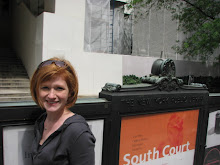Upon entering the centre, there are several places to sit and listen (headphones) to various recordings. The British Library is the National Archive for Recorded sound. They work with all media types including wax cylinders (such as the ones Thomas Edison created in 1877), vinyl, cassettes, CD's, and of course digital media. Their sound recordings are forever being transferred into new media types for preservation purposes. There are specially trained Sound Archivists who perform the processes to conserve original sound recordings, remove distortions and repair damages to the original recordings. There are three main processes to sound archival. In one section of the Conservation Centre, you are able to manipulate digital recordings by turning a dial located in front of the computer screen. It is very interesting to do this while wearing the headset, and at the end of the fine-tuning of your interactive sound archival process, you can compare your own finished product with that of the "real thing". I was only a little bit off with mine, as I had a hard time eliminating the background noise.
The three main processes for sound archival are:
- Speed- adjusting playback speed changes the pitch
- Background noise removal- utilizing a software program called CEDAR, background noise is separated from the main voice
- Treble & Bass adjustments- just like a normal equalizer in your home stereo, archivsts adjust treble and bass to effectively create understandable recordings.
In addition to the sound archival information, there is a plethora of hands-on interactive quizzes that patrons can sit and take part in while at the Conservation Centre. This was very interesting to me, as I was able to "guess" the best method of conserving a book back to its original condition. A book is described and then three options for conservation methods were offered. For example, a 15th century book printed in France on vellum pages and untanned animal skin has the following issues: split spine, worn velvet (rebound) cover, broken head-band. The options for conservation were: rebind with leather, full conservation, starch paste and Japanese paper repair, or place in archival box. (The correct answer is Japanese Paper and starch paste/repair.) After selecting a method, the patron is then informed of the pros and cons of utilizing this method, and then told whether or not it is the best method for conservation of this particular book.
Patrons may also find out more about the problems with old books and why they fall apart so easily. Books throughout the years were often created out of organic materials (animal, mineral, plants) so they decompose over time. Some examples:
- Animal: egg whites for attaching gold leaf, animal skins for book covers
- Vegetable: papers from plant fibers, linen & cotton. Plant based ink.
- Mineral: gold-leaf, iron/carbon inks, paper whiteners, lime to treat vellum
The Conservation Centre also goes over the many different types of damage that books often go through: mold, insect infestation, brittle paper (acid), iron gall, dust and pollution, water and heat damage, amateur repairs, etc.
So mainly the Conservation Centre is an educational resource that explains the types of damage that can occur, how it can be preserved, options for conservation of items, and how conservation is carried out at the British Library.
The British Library attempts every effort to bring items as closely back to their original format as possible. They view the conservation process as a decision-making process, where they must decide what the best route to take is, with minimal intervention. They attempt to use conservation techniques that can be reversed. They consider many factors when deciding which techniques to use: including the cultural home of the piece, the amount of damage, the way it will be accessed/used in the future, etc.
I found this centre to be incredibly interesting, and I look forward to drawing this information in comparison with the techniques and processes carried out in the U.S. The most difficult part about this exhibit was by far my inclination to want to walk past the public-exhibition and into the REAL conservation centre doors that said Staff Only.
So for the average book-lover, this helps people understand the issues with conservation.
















